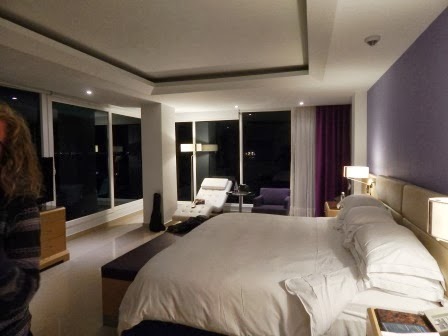From the airy pleasant new airport at Cartagena we took a
Viva Colombia Airbus 320 jet to Medellin in the central highlands of Colombia.
We landed in the green rolling mountains and breathed in the cool
mountain air. We took a bus to the city which wound along 45 minutes through
the countryside. Wondering why the airport was so far from town we soon
realized it was the only flat spot around. Medellin is set in a deep mountain
valley along the Rio Medellin at about 5000 feet altitude (1500 meters).
Most everything is very clean and organized and they are known for their city
planning. You can drink the water. Medellin gets a rap as being the capital of
drug cartels and violent kidnapping, but this is all in the past, and Medellin
is nothing like that, nor is anywhere in Colombia where we visited.
 |
| Viva Colombia Airlines at Medellin |
We stayed at Black Sheep Hostel in the upscale district of
El Poblado. We walked up to an entertainment area near Park Lleras and had a
beer at Club Social and another at Café Tinto Tintero where they were having a
group discussion of success vs happiness. We had dinner at the vegan
restaurant Verdeo, where we had a delicious meal and a break from fried
Colombian food.
 |
| Botero sculpture - Cabeza (Head) - Fernando Botero is the most well known Colombian artist. |
We went on a five hour walking tour of the downtown area of
Medellin. The guide, Pablo, was a passionate young man, who explained that
“Paisas” (people from the Antioquia Medellin area) have the reputation as good
bullshitters and crafty businessmen. These are the two primary qualities of a
tour guide. We went to the government center and Plaza de Luz and along some
commercial areas and stopping at the Metro train. Pablo explained how a hand
grenade had been dropped from a walkway into a crowd where we were standing.
Nobody remembers one hand grenade given the chaos in Colombia in the 80’s and
90’s. But Colombians are a happy lot, and Pablo’s explanation is selective
memory. They don’t remember their supreme court being besieged, or the army killing 2000 civilians and claiming they
were guerillas (Falso positivos), and on and on. No, they remember Colombia beating
Argentina 5-0 to qualify for the 1994 FIFA World Cup. That’s worth remembering.
 |
| Girls clowning around at the old train station. |
 |
| Statue presenting how Medellin was founded |
 |
| Plaza de Luz - Pablo in red shirt explaining how it has changed. |
 |
| Towers in Plaza de Luz. They're lined with LED lights. |
 |
| Botero sculpture - Man on a Horse - His style is alternative proportions. |
 |
| Pretty lady sitting on a Botero statue - Mujer con espejo (woman with mirror) |
 |
| Botero sculpture blown up by a bomb on June 10, 1995 in San Antonio Park. The artist insisted it not be removed. |
 |
| Replacement of the Botero "bird" sculpture located next to blown up sculpture. |
We had lunch along Pasaje Junín at Restaurante Hacienda.
Curtis had the traditional meal called bandeja paisa. It consists of a calorie
busting combo of finely ground meat, white rice, lots of beans, a slab of pork
belly, spicy chorizo, black pudding chorizo, a fried egg, a fried plantain, a
slice of avocado, and an arepa. To top that off we went downstairs to a tea
room and had coffee and wedding cake or black cake which is like fruit cake
with a fancy decorative white frosting.
 |
| Restaurante Hacienda.
Curtis had the traditional meal called bandeja paisa |
 |
| Bandeja Paisa |
Medellin has installed aerial trams and outdoor escalators
to serve poor neighborhoods that are on steep hillsides. To counteract gangs
they have located shining new libraries along transit lines in the worst
neighborhoods. They are trying to include the poor who tend to be the 4 million
internally displaced people of Colombia, who were pushed off the land, mostly
by war and narco-terrorism.
 |
| Elevated section of the Metro train |
We took the clean and sparkly Metro train to the Metro
Cable, and then up to a second tram (4.6 km long) which took us into Parque
Arvi nature preserve at about 2600 meters (8500 feet) altitude. We walked
around and it started raining. Some horse mounted police came along and said
the place was closing. As a diversion, one young policeman took us on a tour of
their brand new horse stable located in the police “fortaleza de carabineros”.
The horses were beautiful and included Belgians, Arabians, and many horses from
Argentina.
 |
| Metro Cable loading area at a Metro station |
 |
| Metro Cable |
 |
| Inside a gondola on the Metro Cable |
 |
| Metro Cable Terminal in Arvi Park |
 |
| Sheri petting a horse at the police stable |





























































